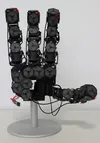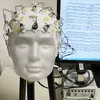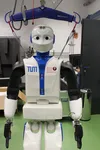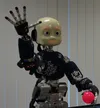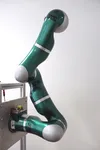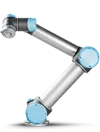4-finger gripper
Two hands with four fingers and sixteen independent torque-controlled joints on each hand are attached to robot TOMM. They are able to hold up to 5 kg.
Compact Omni-directional Mobile Platform
The mobile robot platform used in our TOMM features four Mecanum wheels which provide extraordinary manoeuvrability. Each Mecanum wheel has several independent rollers mounted along its circumference. The axles of the rollers are rotated at 45° against the wheel's main axle. This design enables the robot to instantly move into any direction or turn in place: the Mecanum wheels make it truly omnidirectional.
Gertie
Gertie the Robotic Desk Lamp is a novel research platform that has five degrees of freedom, and is equipped with a camera and microphone in its lamp shade. These features make Gertie a flexible and low-cost resource for conducting research into cognitive products and human-robot interaction.
Gertie will be shown in the museum Pinakothek der Moderne in the Schaudepot from February 2021 on.
iCub
The iCub is the humanoid robot developed at IIT and was adopted by more than 20 laboratories worldwide. It has 53 motors that move the head, arms & hands, waist, and legs. It can see and hear, it has the sense of proprioception (body configuration) and movement (using accelerometers and gyroscopes). We are working to improve on this in order to give the iCub the sense of touch and to grade how much force it exerts on the environment.
Keepon
Keepon is a small robot designed to study social development by interacting with children. It was developed by Hideki Kozima (小嶋 秀樹) while at the National Institute of Information and Communications Technology (NICT) in Kyoto, Japan. Keepon has four motors, a rubber skin, two cameras in its eyes, and a microphone in its nose.
Robot TOMM
TOMM is a robot that was built at the ICS. It consists of two UR-5 arms and a base (compact omni-directional mobile platform). The arms of TOMM are equipped with the artificial robotic skin cells.
NAO
NAO is a programmable, 58cm tall humanoid robot. It has 25 degrees of freedom (DoF) and features two cameras, four directional microphones, a sonar rangefinder, two IR emitters and receivers, one inertial board, nine tactile sensors and eight pressure sensors in its feet. Various communication devices, including voice synthesizer, LED lights, and 2 high-fidelity speakers are part of its design as well as Intel ATOM 1,6ghz CPU (located in the head) that runs a Linux kernel and supports Aldebaran’s proprietary middleware (NAOqi).
PR2
The PR2 has two 7-DOF arms with a payload of 1.8 kilograms. Sensors include a 5-megapixel camera, a tilting laser range finder, and an inertial measurement unit. The "texture projector" projects a pattern on the environment to create 3D information for capture by the cameras. The head-mounted laser scanner measures distance by time-of-flight. The two computers located in the base of the robot are 8-core servers, each of which has 24 Gigabytes of RAM; it runs the popular Robot-OS.

